The AMD Radeon R9 380X Review, Feat. ASUS STRIX
by Ryan Smith on November 23, 2015 8:30 AM EST- Posted in
- GPUs
- AMD
- Radeon
- Asus
- Radeon 300
Overclocking
Finally, no review of a video card would be complete without a look at overclocking performance.
With ASUS setting the STRIX R9 380X’s factory clockspeed to 1030MHz – 60MHz ahead of AMD’s reference clock of 970MHz – ASUS is already significantly eating into the headroom available on the card, and the 1050MHz OC mode further cuts into that. We don’t have any voltage control (we can’t even read the voltage) so the card can only be overclocked as far as the Tonga GPU can go on default voltage. Meanwhile ASUS hasn’t touched the memory clockspeed at all, which should mean there’s a bit more headroom there to play with.
| ASIS STRIX R9 380X Overclocking | ||||
| ASUS STRIX R9 380X OC (Stock) | ASUS STRIX R9 380X (OC) | |||
| Boost Clock | 1030MHz | 1100MHz | ||
| Memory Clock | 5.7Gbps | 6.4Gbps | ||
| Power Limit | 100% | 115% | ||
Ultimately we were able to push the STRIX R9 380X OC from 1030MHz to 1100MHz on the GPU, a 70MHz (7%) overclock. I fully expect that Tonga could do better with more voltage – and the ASUS cooler could keep up – but at the same time it would take a bad power efficiency situation and make it worse. Otherwise memory overclocking was a bit more fruitful, as we were able to push the card from 5.7Gbps to 6.4Gbps, a 700Mbps (12%) performance increase. Note that relative to the original 7970, the R9 380X has a narrower 256-bit memory bus, so if there are any situations where GCN 1.2’s color compression technology can’t make up the difference, a memory overclock may help to close the gap.
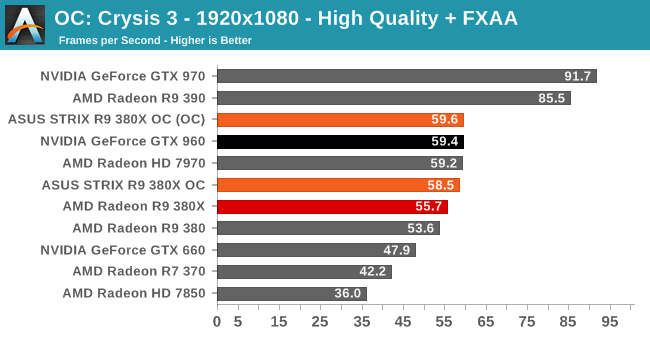
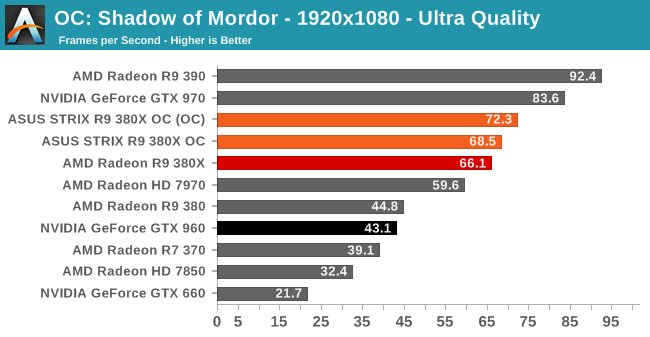
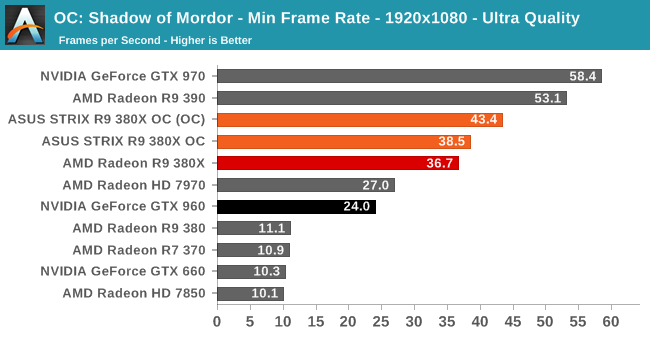
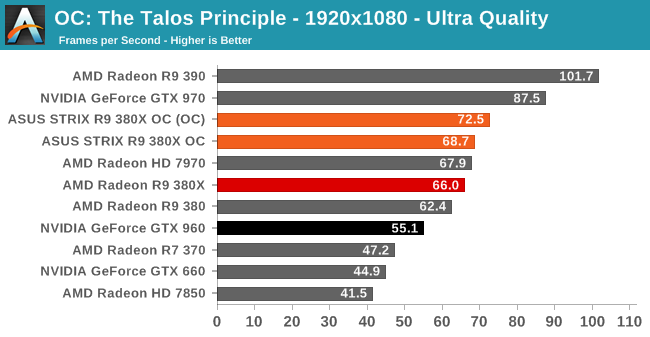
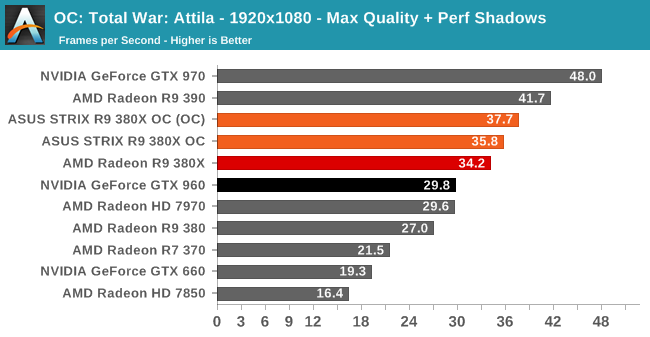
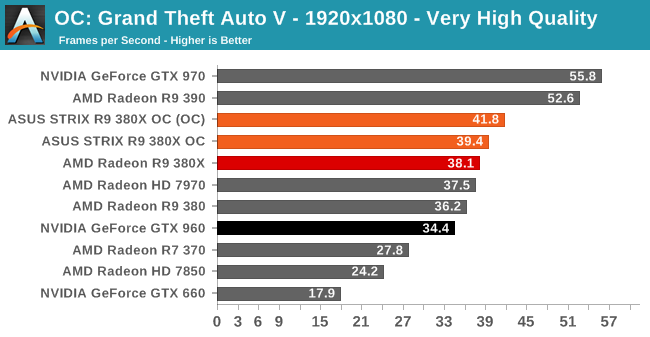
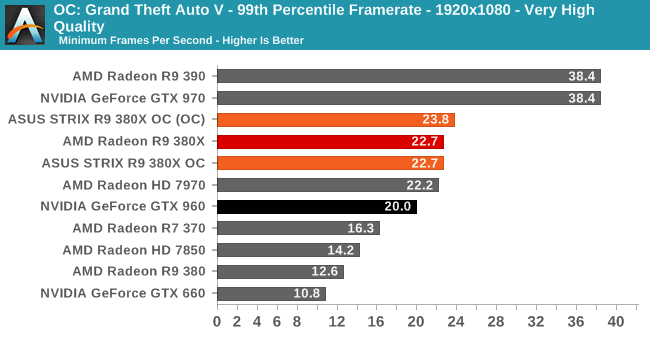
Overall overclocking is good for another 5% performance increase over the STRIX R9 380X's factory overclock. Though enough to be significant, as we guessed base upon the clockspeeds, ASUS has already tapped much of the overclocking headroom available on the card. For reference clocked cards on the other hand, assuming that they can overclock similarly well, this means they can look forward to a total of 10% or so from overclocking.
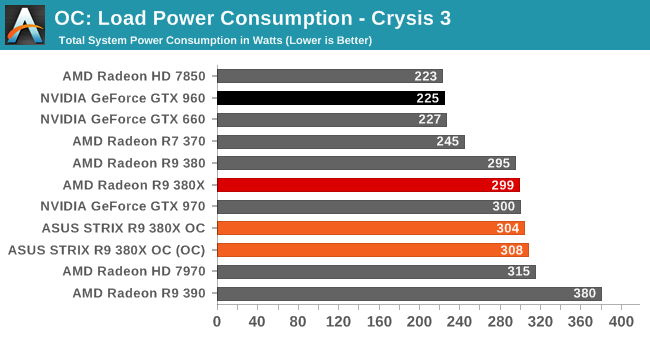
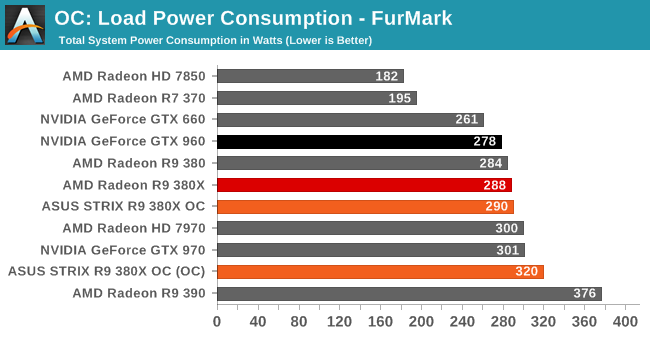
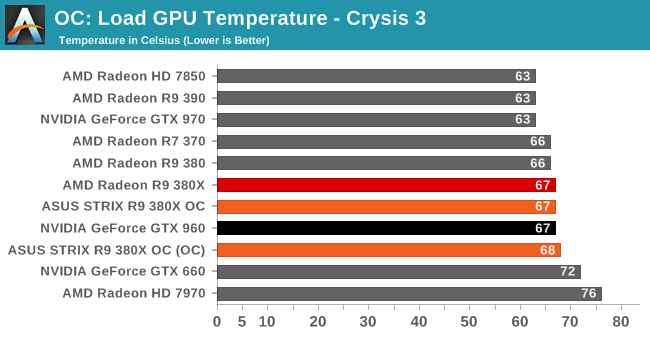
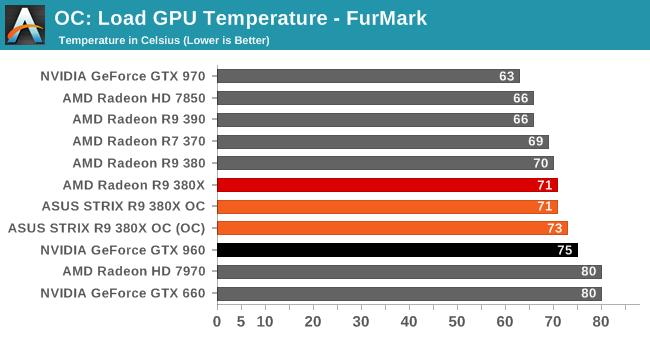
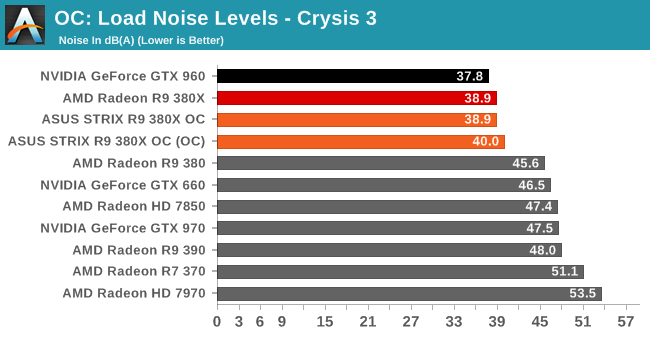
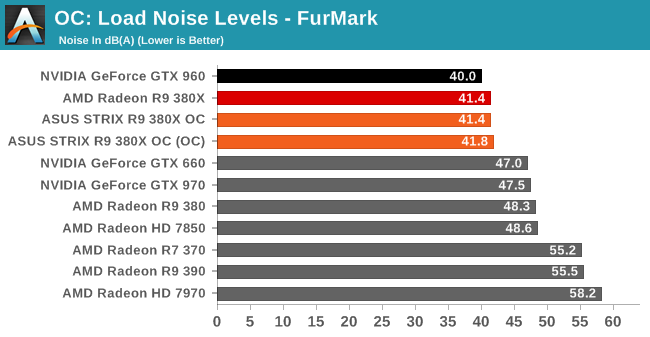
Since we can't overvolt, the power/temp/noise impact of overclocking is limited. Under gaming workloads the difference is a handful of watts and a nothing for temperature or noise. Otherwise FurMark, with the higher power target, pushes the STRIX card a bit harder, but everything still remains within reason.










101 Comments
View All Comments
CaedenV - Monday, November 23, 2015 - link
Card idle so low now that it does not make much of a difference. Even leaving my 4 year old monster on 24/7 is costing me maybe $10-15/year, and with the improved idle power load on newer cards (I am running a 570), it would probably cut that in half.Not to say that you should go crazy and leave things on all of the time because it 'does not matter'... but unless you are running something with a 24/7 load like a render box or a server, then power costs is not a true consideration. Heat generation due to an inefficient card may be a consideration, but not the price of the power used.
rviswas - Monday, November 23, 2015 - link
i was gonna say difference between gtx 860 and this card is less than 5w at idle is says in the review itself look at power consumption.rviswas - Monday, November 23, 2015 - link
gts 960 I meanChaser - Monday, November 23, 2015 - link
Use your AMD GPU to help heat your home. Spoken like a true AMD apologist. LOLlooncraz - Monday, November 23, 2015 - link
Except he's running an nVidia card.Dribble - Monday, November 23, 2015 - link
Too close in price to the 970/390. Anyone spending that much will stretch the extra few $ for the much faster card. Price/performance isn't good enough - needs to be $200.Beany2013 - Tuesday, November 24, 2015 - link
Except when you literally can't afford those extra $ - IE in the UK, the 380X starts around £190, the 970 starts around £250 (using Overclockers.co.uk as a reference).The cost difference there, if all you're doing is upgrading a GPU, is significant enough where you can't really say 'ooh, it's only a little more' - if we were talking £190 and £220, that'd be different.
Likewise, if you're configuring a whole system, and aren't an *avid* gamer (IE, as a survey of one, I mostly dick about in Serious Sam 3 and Metro 2033/Last Light - both of which are far better with a chunky GPU if you like your shiny goodness) then the £60 difference is better spent elsewhere, like RAM, storage, or a larger monitor.
Horses for courses, but if you're trying to eke out as much overall value as possible for a machine without horribly compromising on performance, AMD make a hell of a lot of sense.
Me? I'm waiting for Fiji to come down below £200. And, you know, to get a new job. Which'd probably help, natch.
AndrewJacksonZA - Monday, November 23, 2015 - link
Re: "Finally, we’re also unable to include compute benchmarks for R9 380X at reference clocks, as AMD’s drivers do not honor underclocking options with OpenCL programs."Would someone please be so kind as to explain "underclocking options with OpenCL programs" to me please? Why do the cards need to be underclocked when running OpenCL programs?
Thank you.
Ryan Smith - Monday, November 23, 2015 - link
The card we received is the STRIX R9 380X OC, which comes with a factory overclock of 1030MHz, versus 970MHz for a reference card. We underclock this to get reference performance, however underclocking doesn't work with OpenCL programs.AndrewJacksonZA - Monday, November 23, 2015 - link
OK, got it, thanks Ryan.